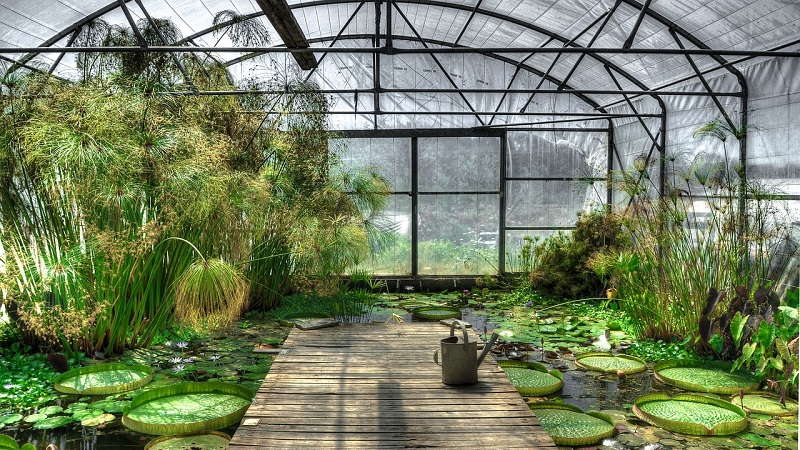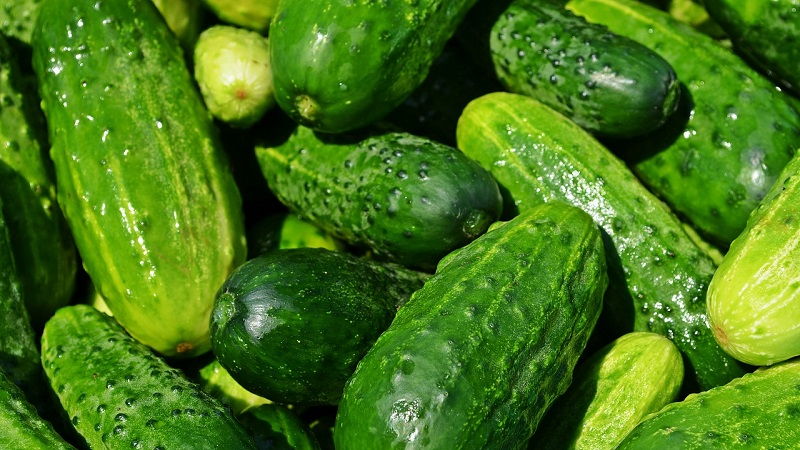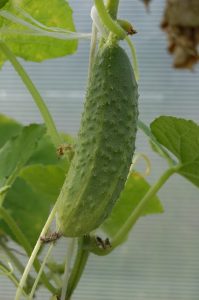Cucumbers are amazingly easy to grow, and there are so many different varieties that adding an assortment of these hardy plants to your garden or greenhouse can bring lots of nutrition, flavour and enjoyment to your mealtimes.
Many types of cucumbers can be harvested on an ongoing basis throughout the summer months. They make an ideal addition to light summer fare, veggie smoothies and specialty summertime drinks. Some types have been developed and bred especially for pickling. Others are ideally suited for slicing. Exotic Asian and Indian specialty cucumbers are excellent for preparing and accompanying exotic dishes or enjoying on their own.
Thanks to the many different varieties and their varied growing habits, you can enjoy cucumbers from early spring until late in the autumn. This is especially true if you are lucky enough to have a greenhouse. You can grow a combination of greenhouse cukes and those that can be grown from start to finish in the garden.
Choose the right plants for your garden, greenhouse or patio

Cucumbers can be divided into two basic types, greenhouse and outdoor or “ridge“. Within these two types there are many different varieties. Cucumbers are also very fine container plants, and they can also be grown in grow-bags. The key to success lies in selecting the right plants for your setting.
Greenhouse cucumbers are easy to grow year-round, and they produce very nice looking fruits of a uniform shape and size. When you grow greenhouse cukes, you do need to take care that they are not pollinated as this will result in bitter tasting fruits.
Be sure to either purchase “all-female” F1 hybrids or remove any male flowers that might appear on your plants. You can tell the difference between male and female flowers because the female flowers have a cucumber-shaped bulge at the base. This will become a cucumber. Male flowers just have a straight stem and no bulge.
Ridge cucumbers are the type that grow outdoors. Outdoor cukes are not as pretty as the greenhouse variety. They are shorter and tend to have rough, bumpy skin. The outdoor variety does need to be pollinated, so you should leave all flowers in place. You don’t need to stress over pollination as long as you have a healthy population of friendly fauna (e.g. bees, butterflies, hummingbirds) in your garden.
While it is possible to grow ridge cukes in a greenhouse, you must be sure not to grow both ridge and greenhouse varieties in the same building. If you do, they may cross-pollinate and your greenhouse variety will produce bitter tasting fruit.
Specialty varieties can add fun and interest to the garden and to your table. There are a number of interesting variations to choose from. For example, there are ball-shaped cukes and some types that are pale yellow or white rather than green. These specialty specimens can be had in both ridge and greenhouse varieties, and the smaller types make great container plants.
Guide to cucumber types

Your choice of plants will also depend upon your plans for the fruits. Some cucumbers are better for slicing, while others are designed for pickling. There are also good all-around varieties that can be used in multiple ways. Here’s a brief guide:
a. Best cukes for slicing
- Sweet Success is a larger, “burpless” variety. Fruits can be a foot long or more.
- Bush Champion is a small plant and fruit that is suitable as a container plant. Fruits typically reach a length of ten inches.
- Green Finger produces very tasty, thin-skinned fruit of eight to ten inches in length.
- Saber is a medium sized plant that produces slim, eight or nine inch long fruits with very thick skins.
- Salad Bush is a very hardy, robust, small plant that produces fruit about eight inches long. This variety resists disease.
- Piccolino is a miniature variety that is especially suited to UK growth. The plants are small, and the cukes reach a maximum length of five inches.
b. Best cukes for pickling
- Adam Gherkin produces plump, evenly shaped fruits with a density of flesh that makes it the perfect choice for pickling.
- National Pickling is a good, all-purpose variety that produces six inch long cucumbers that are good for eating-out-of-hand or pickling.
- Calypso is an F1 variety that produces an abundance of small (typically three inches long) uniform fruits.
- Little Leaf is a small, compact, multi-branched plant that is an excellent choice for container gardens. The vines are good climbers, and the fruits are attractive and of a moderate size.
c. Speciality Asian cukes
- Suyo Long is a “burpless” giant. The crisp, sweet fruit can grow to be over a foot long, and it is excellent for all uses. This is a fine choice if you have limited room and want cucumbers for cooking, pickling, slicing and eating out-of-hand.
- Poona Kheera makes a attractive addition to your garden or greenhouse. The tasty, colourful fruits are pale yellow initially and mature to a deep russet brown. This plant loves to climb and should be trellis trained.
d. Speciality cucumbers with interesting features
- Lemon Cucumber is a good choice as a container plant. This enthusiastic little plant produces small, round, lemony fruits. Its growing season is short, and it prefers cooler conditions. It will do well in a greenhouse through the winter or even in a very sunny window with some artificial light supplementation.
- Boothby Blonde produces small, oval or plum-shaped fruits. They are sweet, colourful and pretty in a creamy shade of yellow with tiny black spines.
How to grow cucumbers from seed
The best time to sow any cucumber seed is between the months of March and April. Sow the seed indoors in advance of the growing season to give plants the best start. If you want to sow outdoor varieties directly in your garden, you can do so during the months of May and June; however, starting them indoors is advised.
When you plant cucumber seeds, you should lay them on their sides in a well-draining seed propagation mix. The seeds should be sown about half an inch deep at a rate of two per 3″ pot.
Once planted and watered, you’ll want to keep the pots at a temperature of about 20 C. Use a propagator or simply place the pots in a clear plastic bag in an area with indirect light to maintain a uniform temperature. You should see new plants in a week to ten days.
After germination, place your little seedlings in a sunny window and/or add supplemental light. You should keep the temperature at about 15-16 degrees Celsius. Be sure your seed starting medium stays lightly moist, but be careful not to over-water. When all danger of frost has passed, you can gradually transition your seedlings outdoors.
Acclimatizing your plants to an outdoor setting must be handled delicately. Begin allowing your plants to have a little time outdoors every day or so once all danger of frost has passed. Start this program a week to ten days before transplanting your seedlings.
Select a transitioning area that has dappled or indirect sunlight and good shelter from harsh winds. After about five days allow a bit more exposure. Eventually, you will want to place your young plants in the garden in full sun spaced about three feet apart.
Growing cucumbers in a greenhouse
Greenhouse cucumbers like an environment that is humid and warm with a steady temperature of about 15 degrees Celsius. Plant your greenhouse cucumbers in grow bags or planters that will allow them to stand about eighteen inches apart. Remember to remove all male flowers from greenhouse varieties.
Warmth and humidity are very important factors in growing cucumbers successfully indoors. Be sure to provide ample and consistent heat (you may need a greenhouse heater) and moisture. Water regularly to keep your planting medium moist, and hose down pathways, spray or provide a humidifier to keep the air humid. Remember that the glass of a greenhouse can amplify the rays of the sun. Watch for signs of scorching and provide protection as needed.
How to stake your cukes for greenhouse growth
In a greenhouse, your space may be quite limited. It’s a good idea to encourage trailing varieties to climb through use of strings or canes. Select the main shoots and train them by attaching them to suspended twine or canes that are at least six feet high. When the plant has reached the apex of its support, pinch off new growth to encourage a bushier plant and a bigger crop.
Growing ridge cucumbers outdoors
When you grow cukes in your garden, you are likely to have a lot more space. If so, you won’t need to go to the extra effort of training your plants to climb. Most garden varieties do very well sprawled about with wild abandon.
You can, and should encourage bushiness by pinching back the main stem once seven leaves have grown. Pinch just above the leaf growth to encourage side shoots, a bushier appearance and more fruit.
When growing cucumbers outdoors, you don’t need to worry about removing half the flowers. Your outdoor plants need pollination, and your friendly fauna will take care of that for you.
General cucumber care & maintenance
 Remember that cucumbers thrive in hot weather. No matter where you plan to grow them, you must be sure you can provide plenty of sun. In order to do well, cucumber plants need between eight and twelve hours of full, bright sunlight daily.
Remember that cucumbers thrive in hot weather. No matter where you plan to grow them, you must be sure you can provide plenty of sun. In order to do well, cucumber plants need between eight and twelve hours of full, bright sunlight daily.
If the area you have in mind does not receive that much sunlight, choose varieties that do well in containers. This way, you can move them as needed to increase sun exposure.
Ample water is also absolutely necessary for growing tasty cucumbers. Cukes are like little watermelons: they are made up of mostly water. Be sure to position your plants so that watering is easy. Putting your garden setting near a faucet helps make maintenance easier.
In addition to lots of sun and lots of water, cucumbers need lots of fertilizer. When you see fruits beginning to form, begin feeding your plants a high potash fertilizer every fourteen days.
Bringing in your harvest
You should have some cucumbers to pick about three months after you plant your seeds. Harvest in the cool of the morning when the fruits retain all the moisture they have absorbed overnight. Use a very sharp knife or pair of clippers to separate the fruits from the vines.
Be sure to begin harvesting as soon as you see mature fruit and continue to harvest often. The best cucumbers are the young, tender ones. If you leave them in place too long, they will go to seed and taste bitter.
Outdoor cukes can be harvested through the month of September. Those grown in a greenhouse can be harvested through the month of October or later if conditions are right.
Abundant cucumbers make gardening fun!
It can be lots of fun to grow cucumbers, and you can add a great deal of flavor, nutrition and enjoyment to your table with these easy-to-grow, versatile garden plants. When you grow cucumbers, you can count on getting plenty of fresh veg throughout the growing season.
You can share generously with your friends. You can even pickle your cucumbers to enjoy during the winter. Follow the advice presented here to enjoy growing cucumbers in your UK garden or greenhouse.
Sources: Thompson & Morgan






So interesting, ready to take notes!